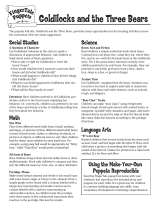Page is loading ...

EI-1740
Ages 4+/Grades Pre-K+
Contents
• Cloth wall chart
• 26 embroider
ed animals, one for
each letter of the alphabet: alligator,
butterfly, cow, duck, elephant, fox,
goat, hippo, iguana, jellyfish,
kangaroo, lion, monkey, newt,
octopus, panda, quail, rhinoceros,
snake, tiger, unicorn, vulture, walrus,
x-ray fish, yak, zebra
Animal Adventures
Use the animals as finger puppets to encourage children to tell
progressive stories. For example, children can tell a story in
alphabetical order using the chart, “Once upon a time there was
an alligator. One day, the alligator was resting near a tree when a
beautiful butterfly landed on a branch. ‘Where are you going?’
yawned the sleepy alligator. ‘I am going to visit my friend the
cow,’ said the butterfly. ‘Would you like to come?’” etc. You can
also put the animals in a bag, seat children in a circle, and invite
them to take turns drawing an animal from the bag, and using it
to add to the story.
Children learn to count with Animal Numbers.
EI-1741 Animal Numbers Activity Center
© 2008 Educational Insights, Inc., Rancho Dominguez, CA (USA).
Learning Resources, Ltd., King's Lynn, Norfolk (UK).
All rights reserved. Conforms to ASTM F 963.
Made in China. Please retain this information.
CUSTOMER SERVICE: (800) 995-4436 Monday–Friday
WEBSITE: www.Educational
I
nsights.com

Children attach the self-stick animals
to the chart to practice a variety of
early reading skills. Versatile animals
can also be used as finger puppets.
Before You Begin
Introduce the chart to your class – reviewing the names of the
different animals – alligator, butterfly, cow, etc.
Activities
Just the Letters
Display the chart without the animals in place so children can
focus on the letters and their names. Point to each letter in
sequential order and have children say its name. Then quiz
children by pointing to the letters in random order. If you wish,
use the chart with the familiar alphabet song below to reinforce
letter identification and alphabetical order in a fun way.
Letter Riddles
Display the chart without the animals in place. Tell children you
are thinking of a secret letter. You will give them clues, and they
will try to guess the letter. Here are some examples:
“I am thinking of the letter that comes after d.”
“I am thinking of the lett
er that comes before w.”
“I am thinking of the lett
er that comes between j and l,” etc.
Listen for the Letter Sound
Display the chart with the animals
in place. Say each animal’s name, in
order, one at a time, emphasizing the
beginning sound – /h/, hippo. T
hen
quiz children, asking them to identify
the letter:
“Which letter makes the sound you
hear at the beginning of the
word fox?”
“Which lett
er makes the sound you
hear at the beginning of the
word monkey?”
“Which letter makes the sound y
ou hear at the beginning
of the word tiger?” etc.
As children answer the questions, hav
e them come up and
remove the animals to check their answers.
Matching Letters and Sounds
Display the chart without the
animals in place. Invite volunteers
to come up and place the animals
on the corresponding letters. The
animal outlines act as visual clues
and help children check their work.
All About Animals
Build vocabulary and early science
skills. Ask children to describe each
animal, including its color, where the
animal lives, the sound it makes, what
it eats, and any other information
children may know about it.
The ABC Song
A - B - C - D - E - F - G
H - I - J - K - L - M - N - O - P
Q - R - S - T - U - V
W - X - Y and Z
No
w I know my ABC’s,
Next time won’t you sing with me?
Which letter makes the
sound you hear at the
beginning of the word duck?
Which animal begins with
the letter m?
/











